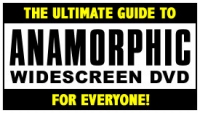I'm sure by now, most of you know that when you go to see a movie in a theater, the screen you watch movies on is shaped differently than your TV screen at home. Properly shown movies appear to be much wider-looking than television programs do. There's a reason for that, and it's all about something called aspect ratios.
So just what exactly are aspect ratios, and how did they come to be? Well sit right back, and I'll tell you the whole story...
RealD, 3DTV, Blu-ray 3D, active shutter glasses - these are terms you've probably heard mentioned on TV and in trips to Best Buy and other retailers. Certainly, anyone who's gone to a movie in theatres in recent months has heard about (or experienced) 3D on the big screen, with such hit films as Avatar, Toy Story 3 and How to Train Your Dragon. There's little doubt that 3D is here, and here to stay. What's more, the technology has finally arrived for you to enjoy the 3D experience in your living room. But what does it all mean? How does it work, and what special equipment do you need to give it a try?
The following is a comparison of anamorphic and non-anamorphic (letterboxed) widescreen DVD video, as displayed on Standard 4x3 and Digital 16x9 TVs. For this demonstration, we've chosen to use snapshots of actual DVD video from the film Rushmore (aspect ratio is 2.35:1). Buena Vista's original DVD version (on the left) is non-anamorphic. By contrast, The Criterion Collection DVD release (on the right) is anamorphic.
The following is a comparison of anamorphic and non-anamorphic (letterboxed) widescreen DVD video, as displayed on Standard 4x3 and Digital 16x9 TVs. For this demonstration, we've chosen to use snapshots of actual DVD video from the film Good Will Hunting (aspect ratio is 1.85:1). Buena Vista's U.S. DVD version (on the left) is non-anamorphic. By contrast, Alliance's Canadian DVD release (on the right) is anamorphic.
As the editor of The Digital Bits, I'm proud to present you with The Ultimate Guide to Anamorphic Widescreen DVD for Everyone! - the Everyperson's bible to DVD's most important video quality feature.
You may remember the first editorial I did on this subject back in 1998: The Big Squeeze: The ABCs of Anamorphic DVD. Lots of you have let me know that the editorial helped you to better understand just exactly what anamorphic is and how it works. But we still get tons of e-mail from puzzled readers asking questions about it. I recently did some research of my own, and started looking at the various resources available on the subject (both online and in various print publications). What I discovered, is that while there are lots of good articles on anamorphic widescreen, most of them are written in very technical terms and are difficult for even reasonably savvy DVD consumers to understand. Given the vigorous position in support of anamorphic widescreen that we've taken here at The Digital Bits, I decided to assemble what I hope will become the most clear and easy-to-understand guide on the subject. And it will always be just a click away, easily accessed by pointing your mouse at the familiar Anamorphic Widescreen logo found on every page of the Bits.


